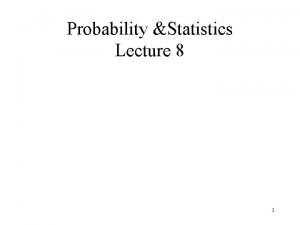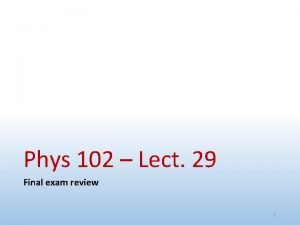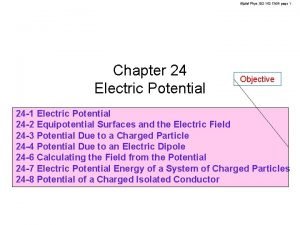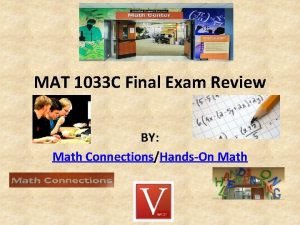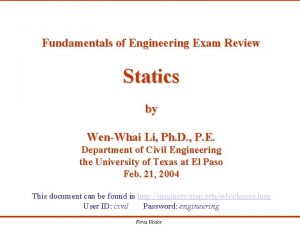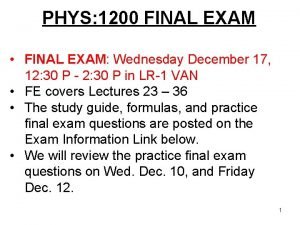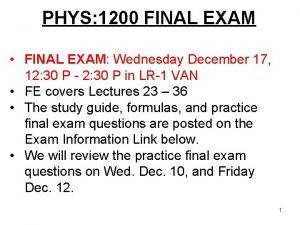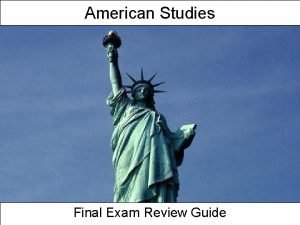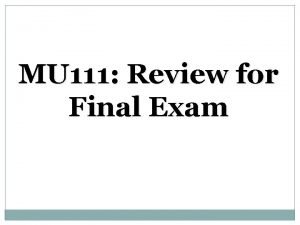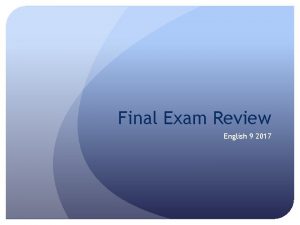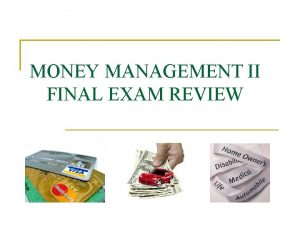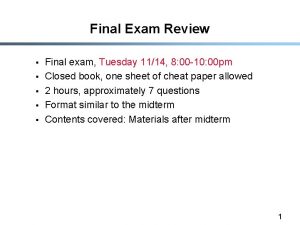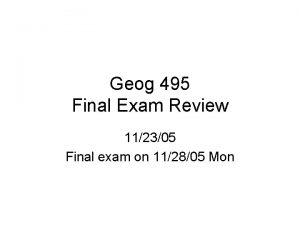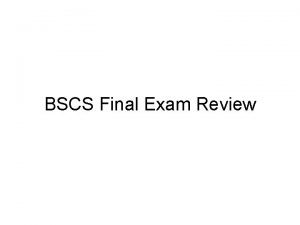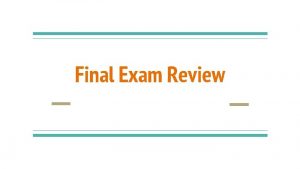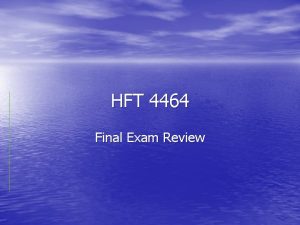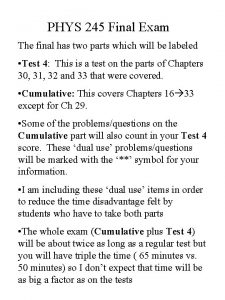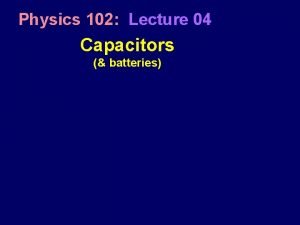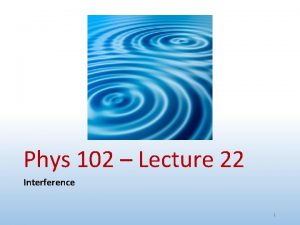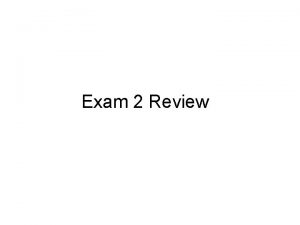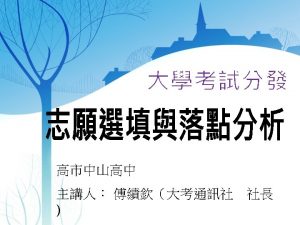Phys 102 Lect 29 Final exam review 1







![Relationship between F, E, UE, V F Number (“scalar”) UE [N] Ex: [J] Ex: Relationship between F, E, UE, V F Number (“scalar”) UE [N] Ex: [J] Ex:](https://slidetodoc.com/presentation_image_h/d8e7c02eb7069abe6f0b850b9b2c41b3/image-8.jpg)
















- Slides: 24

Phys 102 – Lect. 29 Final exam review 1

Final exam study approaches How should you study for the physics exam? • Cramming DOES NOT work • Emphasize understanding concepts & problem solving, NOT memorization • Review pre-lecture & lecture concepts • Review problems: ACTs, HW, quizzes, practice exams • Understand formula sheet (i. e. when to use and when NOT to use an eq. ) & know what each symbol means • Do practice exam problems (time yourself!) Phys. 102, Review 29, Slide 2

Review lecture ACTs Some exam problems are inspired by ACTs. EX 2 30% 70% Phys. 102, Review 29, Slide 3

Review homework questions Some exam problems are inspired by the HW. EX 2 20%! 100% Phys. 102, Review 29, Slide 4

Problem solving approaches The not-so-good approaches: EX 2 “Reasoning by analogy”/memorization: “I remember every time we’ve done RC circuit problems, VC = after a long time. . . ” The good approach: Conceptual understanding / reasoning from basic principles: 20%! 1. 2. 3. 4. The capacitor is fully charged, so IC = 0 Resistor R 3 is in series with C so I 3 = 0 But, current can flow around inner loop, so I 1 > 0 Algebra! KLR: – I 1 R 1 – VC = 0, therefore VC < Phys. 102, Review 29, Slide 5

Problem solving approaches The not-so-good approaches: EX 2 The “magic” equation: “What equation will solve this problem? Req = R 1+R 2, V = IR? ” The good approach: Conceptual understanding / reasoning from basic principles: 70% 1. 2. 3. 4. Redraw the circuit to make it clearer The rightmost resistor is shorted, so no current flows through it! So, the current through the bottom resistor is I Algebra! KLR: E – IR = 0 Phys. 102, Review 29, Slide 6

1. Electricity & circuits Lects. 1 – 9 7
![Relationship between F E UE V F Number scalar UE N Ex J Ex Relationship between F, E, UE, V F Number (“scalar”) UE [N] Ex: [J] Ex:](https://slidetodoc.com/presentation_image_h/d8e7c02eb7069abe6f0b850b9b2c41b3/image-8.jpg)
Relationship between F, E, UE, V F Number (“scalar”) UE [N] Ex: [J] Ex: po Pro in per t i ty n sp of ac e in te Pro ra pe ct r in ty gc o ha f rg es Vector E Ex: V [N/C]=[V/m] E points from high to low V [J/C]=[V] Ex: Phys. 102, Review 29, Slide 8

Circuits & components Wire Battery Series and parallel Capacitor Resistor Basic principles: Conservation of charge (KJR) Conservation of energy (KLR) 1 1 2 2 Current In = Current Out Sum of voltages around loop = 0 Phys. 102, Review 29, Slide 9

RC Circuits Charging: Discharging: Immediately after (t = 0): No charge on C yet Current IC, 0 flows charge onto C Immediately after (t = 0): C still fully charged Current IC, 0 flows charge off of C Initially the capacitor is uncharged At t = 0 we close switch S 1 Initially the capacitor is fully charged At t = 0 we close switch S 2 ε R + C acts like a wire After a long time (t = ): Charge on C builds and saturates Current decreases to zero C acts like an open circuit +Q –Q S 1 IC C S 2 C acts like a battery After a long time (t = ): Charge dissipates to zero Current decreases to zero C acts like an open circuit Phys. 102, Review 29, Slide 10

2. Magnetism Lects. 10 – 15 11

Magnetism summary Type I: RHR forces on moving charges and currents Type II: RHR for magnetic fields generated by currents B field from wire Moving + charges and currents Moving – charges B field inside loop I I + I q – q I I I Thumb along Fingers along on + q is out of palm Thumb along Fingers along on – q is into palm Thumb along I Curl fingers along Thumb along OR: Thumb along I Curl fingers along Phys. 102, Review 29, Slide 12

Lenz law Induced EMF ε opposes change in flux 1. Is increasing, decreasing, or constant? 2. If increases: ε induces B field opposite external B field If decreases: ε induces B field along external B field Bext I Bind I Top view Side view I Bind Side view If is constant: ε is zero, no induced B field Bind I 3. Type II RHR gives current direction Curl fingers along I Thumb along Bind I Bind Phys. 102, Review 29, Slide 13

Faraday’s law: “Induced EMF” = rate of change of magnetic flux , 3 things can change Since 1. Area of loop 2. Magnetic field B 3. Angle φ B(t) v B +1. 0 ω +0. 5 0 0 10 20 n B t -0. 5 -1. 0 Phys. 102, Review 29, Slide 14

3. Light & optics Lects. 16 – 23 15

Light summary Properties of electromagnetic waves Relation between E, B, f, λ Energy density, power & intensity Polarization Ray model of light Reflection Refraction Mirrors Lenses (alone, in combination) The eye (nearsightedness, farsightedness) Interference Constructive and destructive interference Diffraction & resolution Phys. 102, Review 29, Slide 16

Light as a wave (again) Interference: phase shift & path length difference Phase shift Constructive: phase shift of mλ Destructive: phase shift of (m + ½)λ θ d θ θ Two & multiple slit maxima Two slit minima Single slit minima Circular aperture minimum Phys. 102, Review 29, Slide 17

Example: Interference Extra practice Phys. 102, Review 29, Slide 18

4. Modern physics Lects. 23 – 28 19

Quantum mechanics Wave-particle duality Matter waves – particle as a wave (de Broglie) Photons – light as a particle (photoelectric effect) Bohr model quantized orbits & energies, electronic transitions Quantum model quantum numbers (n, ℓ, ms), Pauli exclusion principle, magnetic properties of atoms Nuclear & particle physics structure of nucleus & nucleons decay processes (α, β, γ) & rates, binding energy quark model Phys. 102, Review 29, Slide 20

Example: wave-particle duality Extra practice Phys. 102, Review 29, Slide 21

Example: quantum numbers Extra practice Phys. 102, Review 29, Slide 22

Example: quantum atom Extra practice Phys. 102, Review 29, Slide 23

Example: nuclear decay Extra practice Phys. 102, Review 29, Slide 24
 Var lect
Var lect Ap gov final review
Ap gov final review Physics 102 final exam
Physics 102 final exam Phys 102 uiuc
Phys 102 uiuc Aljalal phys 102
Aljalal phys 102 Aljalal phys 102
Aljalal phys 102 World history spring final exam review answers
World history spring final exam review answers Spanish 1 review packet answer key
Spanish 1 review packet answer key Human body systems final exam
Human body systems final exam Poe practice test kinematics answers
Poe practice test kinematics answers Ied final exam
Ied final exam World history semester 2 review
World history semester 2 review Entrepreneurship 1 final exam review
Entrepreneurship 1 final exam review Spanish 2 review packet answers
Spanish 2 review packet answers End of semester test environmental science b edmentum
End of semester test environmental science b edmentum Ap world history final exam
Ap world history final exam Us history semester 2 review
Us history semester 2 review English semester 2 final exam
English semester 2 final exam Physics fall final exam review
Physics fall final exam review Physical science final exam review
Physical science final exam review Mat1033c
Mat1033c Fe exam statics
Fe exam statics Zoology semester 1 exam review answers
Zoology semester 1 exam review answers Earth science final
Earth science final Algebra 1 final review packet
Algebra 1 final review packet
